You can bring fresh flowers on a plane in your carry-on luggage, as TSA allows cut flowers and floral arrangements through security checkpoints without specific plant material restrictions. However, you’ll need to remove any water-filled tubes or containers since they violate the 3-1-1 liquids rule, and your bouquet must fit within airline size limits of approximately 22 x 14 x 9 inches. Understanding proper preparation techniques and international biosecurity requirements will guarantee your flowers arrive safely at your destination.
TLDR
- Fresh flowers are allowed in carry-on luggage and must be laid flat in bins during X-ray screening.
- Water tubes exceeding 3.4 ounces violate TSA’s 3-1-1 liquids rule and must be removed before security.
- Use damp paper towels wrapped in plastic to maintain flower hydration without triggering liquid restrictions.
- Flower arrangements must fit airline carry-on size limits, typically 22 x 14 x 9 inches and under 15-22 pounds.
- International flower transport requires phytosanitary certificates and honest customs declaration to prevent ecosystem contamination.
TSA Security Checkpoint Rules for Fresh Flowers
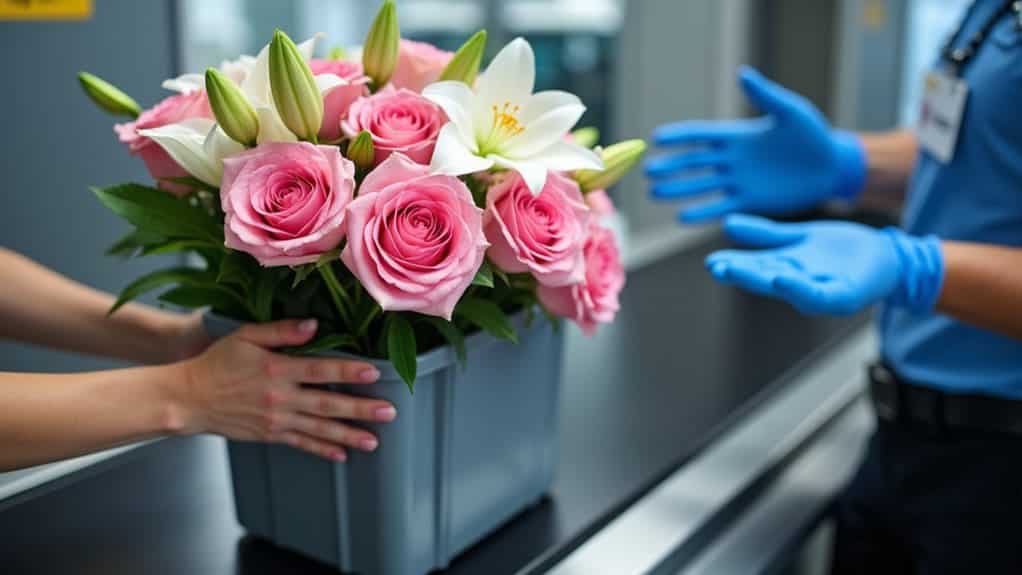
When you’re planning to carry fresh flowers through airport security, you’ll be pleased to know that TSA generally allows them in your carry-on luggage without any inherent restrictions. However, TSA officers focus on detecting objects hidden within or around the flowers, such as liquids, wires, or other prohibited items that could pose security risks. During the screening process, your bouquet will need to be laid flat in a bin to go through the X-ray machine properly. Additionally, it’s important to ensure that flowers are wrapped properly to maintain their freshness while traveling.
X-ray Screening Process and Requirements
As your flowers pass through TSA security, they’ll undergo x-ray screening using cabinet machines that produce detailed images of your carry-on contents. These machines emit low levels of ionizing radiation but are heavily shielded for safety. Additionally, it is important to ensure that any items in your carry-on comply with TSA regulations to avoid complications during screening. Your floral arrangements may appear unclear on x-ray images due to wet wrapping materials, potentially requiring additional manual inspection by officers. TSA officers typically prefer visual inspections over more invasive examination methods when conducting secondary screening of your flowers.
Liquid Restrictions and Water-Filled Arrangements
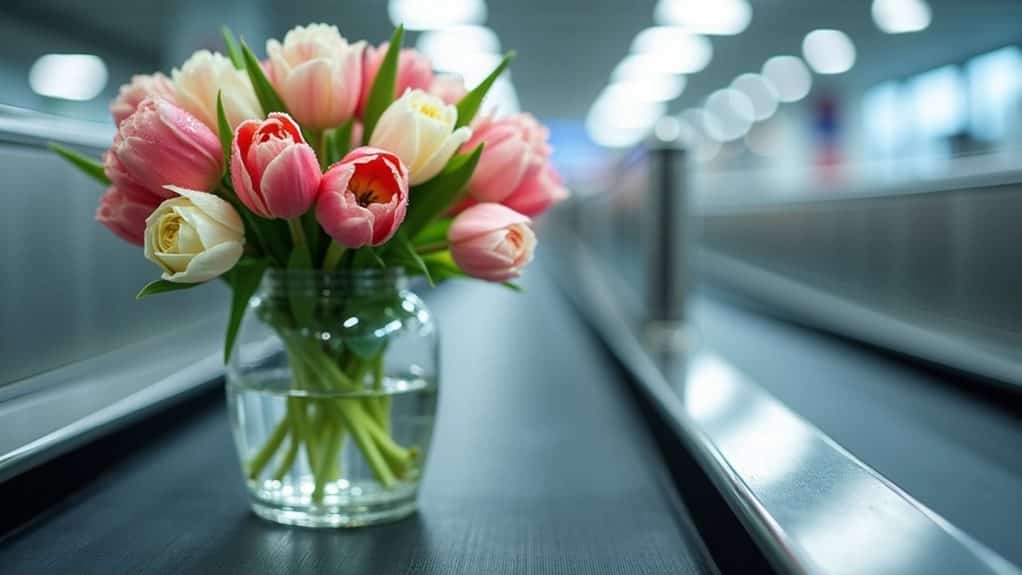
When you’re traveling with flowers, TSA’s 3-1-1 liquids rule creates significant challenges for water-filled arrangements, as water tubes and saturated floral foam typically exceed the 3.4-ounce limit and aren’t allowed in carry-on luggage.
You’ll need to remove or replace traditional water tubes that florists use, since these liquid containers will likely be confiscated at security checkpoints.
Instead, you can wrap your flowers with damp tissue or use pre-moistened materials sealed in leak-proof packaging to maintain freshness while complying with liquid restrictions. Additionally, be mindful of proper packing techniques to ensure your flowers arrive safely at your destination.
Water Tube Restrictions
Although flowers themselves pose no security threat, the water tubes commonly used to keep stems fresh create significant complications at TSA checkpoints.
These liquid-filled containers typically exceed the 3.4-ounce limit established by the 3-1-1 rule, making them prohibited in carry-on luggage.
You’ll need to empty the tubes or remove them entirely before passing through security screening.
Floral Foam Limitations
Floral foam presents unique challenges for air travelers since TSA classifies water-saturated foam as a liquid rather than a solid material.
You can’t bring wet floral foam in carry-on bags because it exceeds the 3.4-ounce liquid limit.
However, completely dry foam is permitted as a solid item, so consider drying arrangements before travel or packing saturated foam in checked luggage.
Damp Tissue Alternatives
TSA’s 3-1-1 liquid rule creates significant obstacles for travelers hoping to keep their flowers hydrated during flights.
Water-filled tubes exceed the 3.4-ounce limit and aren’t permitted in carry-ons.
However, you can wrap flower stems in damp tissue or paper towels, then secure them with plastic wrap.
This method maintains moisture without violating liquid restrictions while keeping your flowers fresh.
Airline Carry-On Policies for Floral Items
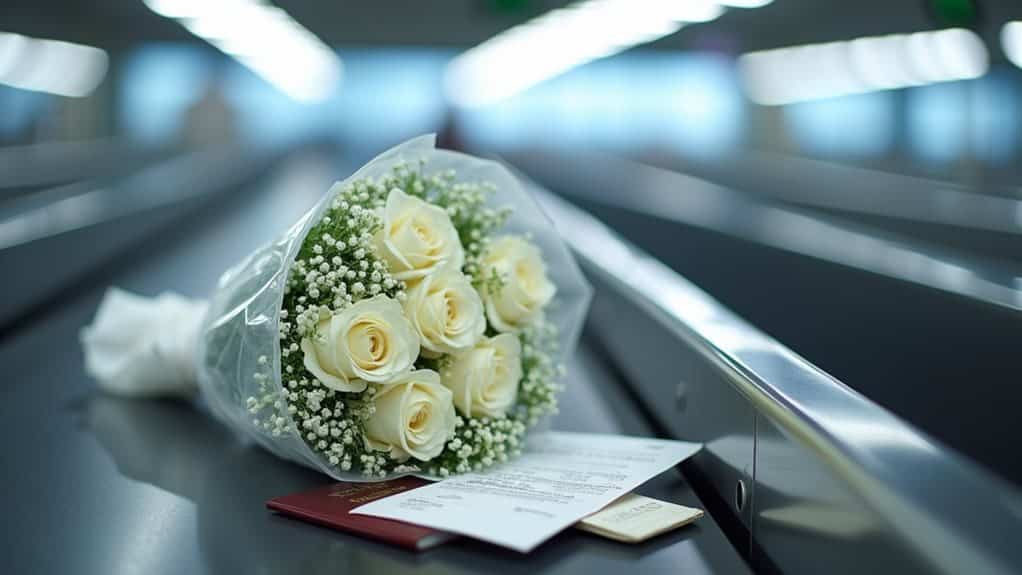
You’ll need to verify your flower arrangement fits within your airline’s standard carry-on size restrictions, which typically measure around 22 x 14 x 9 inches for most major carriers.
The total weight of your flowers and carry-on bag must stay under the airline’s weight limit, usually between 15-22 pounds depending on the carrier.
Proper packaging becomes vital since you’ll want to wrap your flowers in breathable materials like paper or plastic without any water-filled containers, using damp tissue around the stems instead to maintain freshness while complying with liquid restrictions. Additionally, it’s important to be aware of Delta’s carry-on requirements to avoid any last-minute issues at the gate.
Size and Weight Limits
When planning to bring flowers aboard an aircraft, understanding carry-on size and weight restrictions becomes essential for a smooth travel experience.
Most U.S. airlines allow carry-on bags measuring 22″ x 14″ x 9″, with weight limits typically ranging from 15 to 40 pounds.
Your floral arrangements must fit within these standard dimensions and contribute to total weight allowances.
Packaging Requirements Guidelines
Beyond meeting dimensional requirements, proper packaging plays an essential role in successfully transporting flowers through airport security and onto your flight.
You’ll need breathable materials like paper or plastic sleeves that won’t obscure X-ray visibility.
Avoid liquid-filled tubes or dense foam, opting instead for damp paper towels around stems to maintain freshness without triggering security concerns.
Checked Baggage Guidelines for Flower Transportation
Three key considerations determine your success when transporting flowers in checked baggage: proper packaging, compliance with liquid restrictions, and understanding security protocols.
You’ll need to remove all water from bouquets, wrap flowers securely in dry materials, and use rigid containers for protection.
TSA screens checked flowers through X-ray inspection and reserves inspection rights.
International Travel Restrictions and Customs Regulations
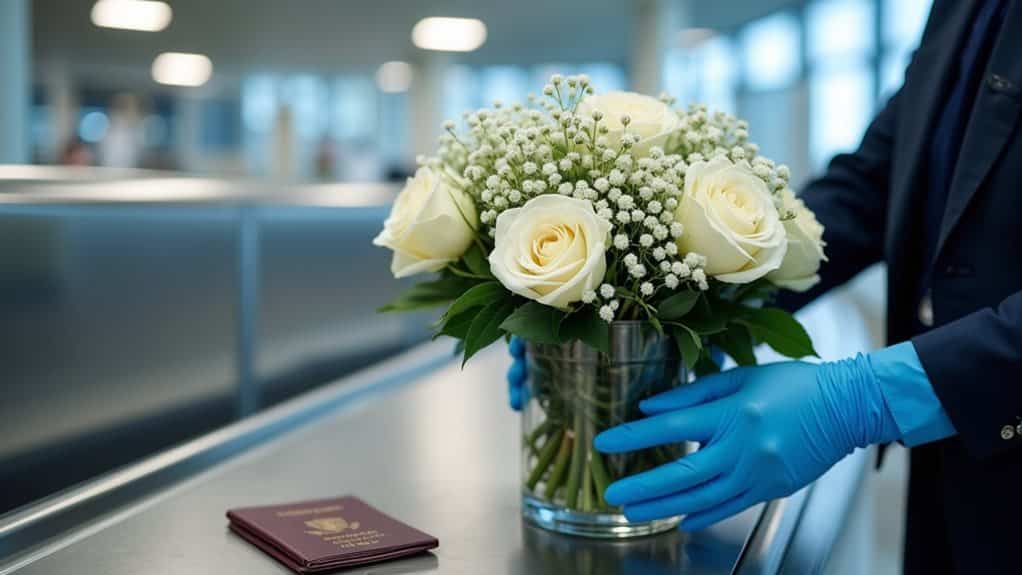
International flower transportation becomes considerably more complex once you cross borders, as customs and agricultural authorities implement strict regulations to protect their ecosystems from invasive species and plant diseases.
You’ll need phytosanitary certificates, import permits, and must declare flowers honestly.
Australia and New Zealand enforce particularly strict rules, often requiring special documentation or prohibiting certain species entirely.
Proper Packaging Techniques for Air Travel
When you’re preparing flowers for air travel, you’ll need to perfect three essential packaging techniques that work within airline restrictions.
Your primary challenge involves keeping stems hydrated without violating TSA’s 3-1-1 liquid rule, which means you can’t bring vases or containers with more than 3.4 ounces of water.
You’ll also need to select protective materials that shield delicate petals during security screening while ensuring your floral arrangement passes through checkpoints without delays.
Moisture Without Liquid Restrictions
Although TSA’s 3-1-1 liquids rule prohibits water containers over 3.4 ounces in carry-on bags, you can still keep your flowers properly hydrated during air travel through clever moisture-retention techniques.
Wrap flower stems in damp paper towels, then seal with plastic wrap to prevent leakage. This florist-approved method maintains freshness for several hours without violating liquid restrictions.
Protective Container Selection
Three essential factors determine whether your flowers survive air travel intact: container durability, proper sizing, and strategic packing techniques.
Choose rigid plastic containers or reinforced cardboard boxes with ventilation holes to prevent crushing while allowing airflow.
Make certain your container fits TSA carry-on restrictions of 22 x 14 x 9 inches, and clearly label it “Fresh flowers, no liquid” for smoother security screening.
Security Screening Preparation
After securing the right container, you’ll need to prepare your flowers for TSA security screening by addressing water restrictions and packaging requirements.
Remove excess water from stems and vases, as containers over 3.4 ounces violate TSA liquid rules.
Wrap stems in damp paper towels sealed with plastic wrap to maintain hydration without triggering confiscation during screening.
Maintaining Flower Freshness Without Liquids
Five key preparation steps can help maintain flower freshness during air travel without violating TSA liquid restrictions.
Cut stems at 45° angles under water, then wrap them in damp paper towels before sealing in plastic bags.
Remove lower leaves to prevent bacterial growth, and use rubber bands to secure bundles, minimizing movement damage during transport.
Security Screening Time and Inspection Procedures
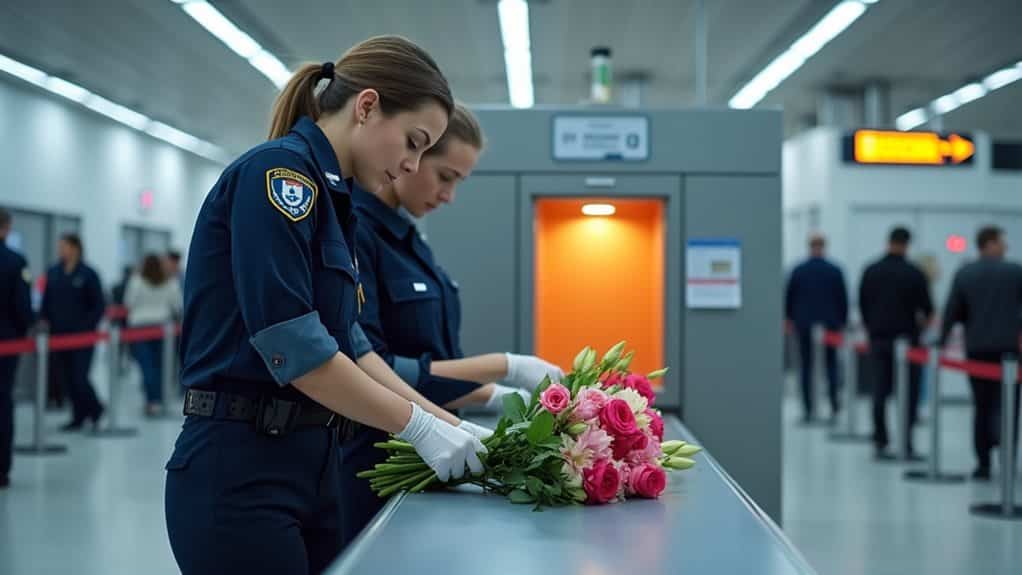
When you arrive at airport security with flowers, TSA officers will guide your bouquet through standard X-ray screening procedures that typically take just a few minutes.
However, if your arrangement triggers alarms or appears suspicious, officers may conduct manual inspections or swab testing for explosives.
Larger bouquets or exotic materials might require additional screening time.
Choosing Flight-Friendly Flower Types and Arrangements
Beyond managing security procedures, selecting the right flowers can make the difference between arriving with a beautiful bouquet or wilted stems.
You’ll want sturdy varieties like roses, orchids, and lilies with thick stems and durable petals. Avoid delicate options such as tulips or gardenias that bruise easily.
Choose cut flowers over potted plants to simplify your travel experience.
Documentation and Biosecurity Requirements for Plant Materials
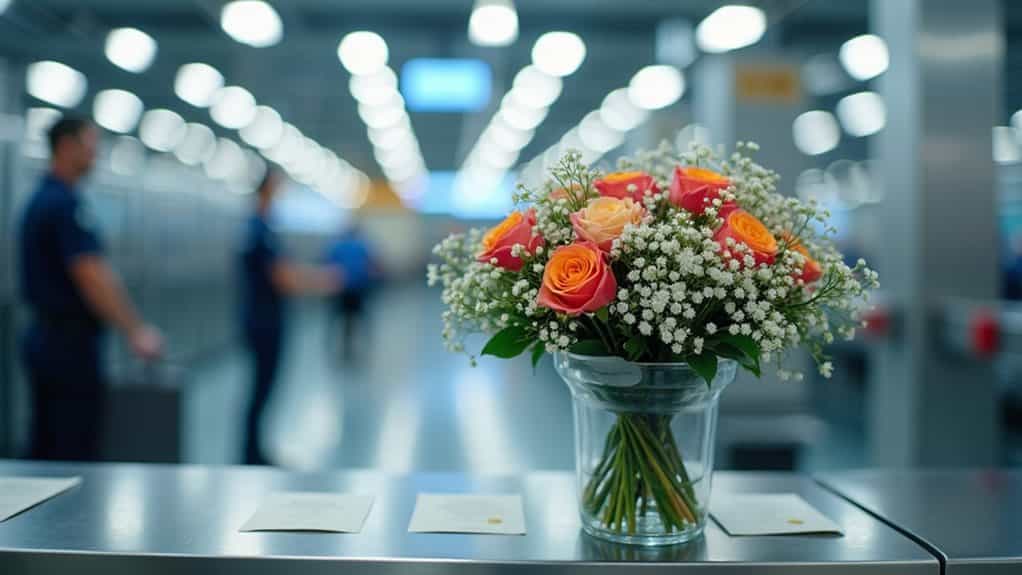
While selecting the right flowers matters for travel durability, understanding documentation and biosecurity requirements becomes essential when crossing international borders.
You must declare all plant materials to U.S. Customs and Border Protection upon entry. Keep original packaging and receipts to prove origin.
Proper labeling with species identification, source information, and permit numbers guarantees smooth inspection processes and prevents delays.
And Finally
You can bring fresh flowers on planes with proper preparation and planning. Remove all water from arrangements before security screening, choose sturdy flower varieties that’ll survive without moisture, and arrive early for potential additional inspections. Check your airline’s specific policies, as some restrict oversized arrangements in carry-on bags. For international flights, research destination biosecurity requirements to avoid confiscation. Following TSA guidelines guarantees you’ll successfully transport your floral gifts through airport security.



